苏教版译林牛津初中英语语法总结(初一初二)
- 格式:doc
- 大小:14.00 KB
- 文档页数:4
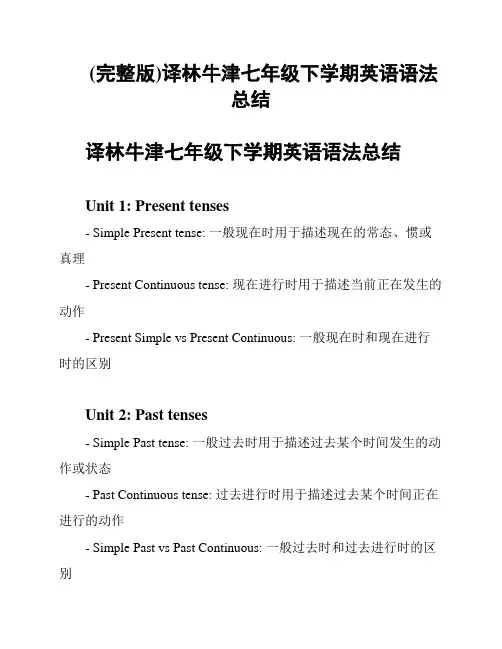
(完整版)译林牛津七年级下学期英语语法总结译林牛津七年级下学期英语语法总结Unit 1: Present tenses- Simple Present tense: 一般现在时用于描述现在的常态、惯或真理- Present Continuous tense: 现在进行时用于描述当前正在发生的动作- Present Simple vs Present Continuous: 一般现在时和现在进行时的区别Unit 2: Past tenses- Simple Past tense: 一般过去时用于描述过去某个时间发生的动作或状态- Past Continuous tense: 过去进行时用于描述过去某个时间正在进行的动作- Simple Past vs Past Continuous: 一般过去时和过去进行时的区别Unit 3: Future tenses- Will + verb: 表示将来的决定、打算或预测- Be going to + verb: 表示计划、意图或预测- Future Continuous tense: 将来进行时用于描述将来某个时间正在进行的动作- Future Simple vs Be going to: 将来时的两种表达方式的区别Unit 4: Passive voice- Active voice vs Passive voice: 主动语态和被动语态的区别- How to form the passive voice: 构成被动语态的方法- Passive voice with different tenses: 不同时态的被动语态形式Unit 5: Modal verbs- Can, could, may, might: 表示能力、允许或可能性- Must, have to: 表示必须、责任或推测- Should, ought to: 表示应该、建议或期望Unit 6: Conditionals- Zero conditional: 表示真理、自然法则或普遍情况- First conditional: 表示可能性、条件或可能的反应- Second conditional: 表示假设、不太可能的情况或对应的行动- Third conditional: 表示虚构、过去的假设或悔恨Unit 7: Reported speech- Reporting verbs: 常用的引述动词- Reporting statements: 直接引述陈述句的变化- Reporting questions: 直接引述疑问句的变化以上是译林牛津七年级下学期英语语法总结的内容。
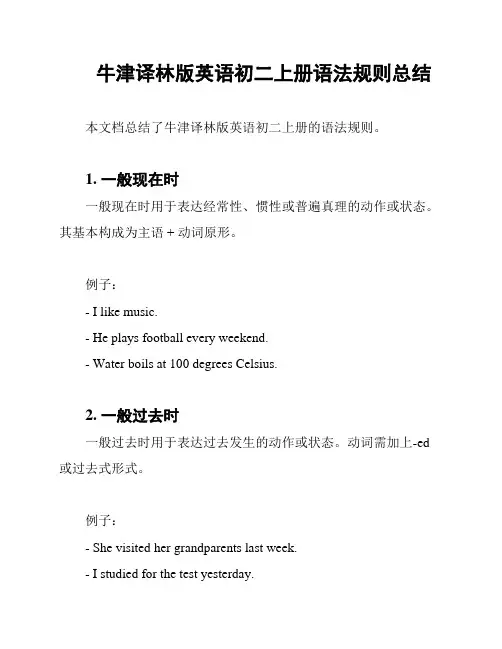
牛津译林版英语初二上册语法规则总结本文档总结了牛津译林版英语初二上册的语法规则。
1. 一般现在时一般现在时用于表达经常性、惯性或普遍真理的动作或状态。
其基本构成为主语 + 动词原形。
例子:- I like music.- He plays football every weekend.- Water boils at 100 degrees Celsius.2. 一般过去时一般过去时用于表达过去发生的动作或状态。
动词需加上-ed 或过去式形式。
例子:- She visited her grandparents last week.- I studied for the test yesterday.- They played basketball for two hours.3. 现在进行时现在进行时用于表达目前正在进行的动作。
其构成为主语 + am/is/are + 动词-ing形式。
例子:- We are watching a movie right now.- The baby is sleeping.4. 一般将来时一般将来时用于表达将来某个时间会发生的动作。
其构成为主语 + will + 动词原形。
例子:- We will go shopping tomorrow.- She will call you later.- They will visit their relatives next month.5. 一般过去将来时一般过去将来时用于过去将来某个时间会发生的动作。
其构成为主语 + was/were going to + 动词原形。
例子:- He said he was going to visit his parents yesterday.- I thought we were going to have a meeting last night.6. 祈使句祈使句用于表示命令、请求或建议。
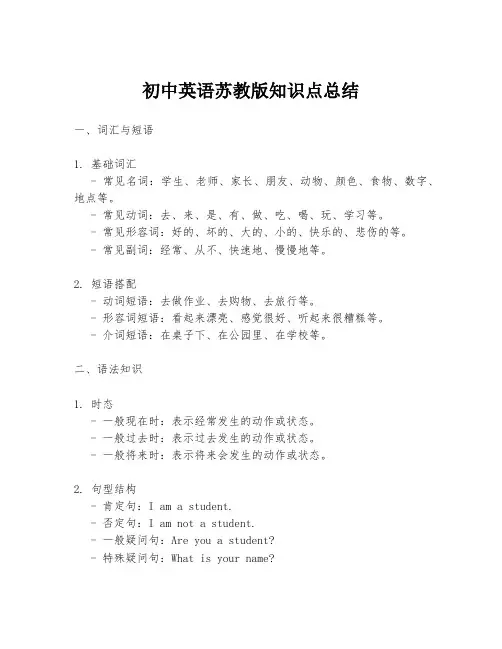
初中英语苏教版知识点总结一、词汇与短语1. 基础词汇- 常见名词:学生、老师、家长、朋友、动物、颜色、食物、数字、地点等。
- 常见动词:去、来、是、有、做、吃、喝、玩、学习等。
- 常见形容词:好的、坏的、大的、小的、快乐的、悲伤的等。
- 常见副词:经常、从不、快速地、慢慢地等。
2. 短语搭配- 动词短语:去做作业、去购物、去旅行等。
- 形容词短语:看起来漂亮、感觉很好、听起来很糟糕等。
- 介词短语:在桌子下、在公园里、在学校等。
二、语法知识1. 时态- 一般现在时:表示经常发生的动作或状态。
- 一般过去时:表示过去发生的动作或状态。
- 一般将来时:表示将来会发生的动作或状态。
2. 句型结构- 肯定句:I am a student.- 否定句:I am not a student.- 一般疑问句:Are you a student?- 特殊疑问句:What is your name?3. 代词- 人称代词:I, you, he, she, it, we, they.- 物主代词:my, your, his, her, its, our, their.- 反身代词:myself, yourself, himself, herself, itself, ourselves, yourselves, themselves.4. 冠词- 不定冠词:a, an.- 定冠词:the.5. 介词- 表示时间:at, on, in.- 表示地点:at, on, in, under, above, behind.- 表示方向:to, towards, through.6. 连词- 并列连词:and, but, or, so.- 从属连词:because, since, although, if, when, while.三、阅读理解1. 文章类型- 记叙文:讲述人物、事件的故事。
- 说明文:解释事物的特性、原因、过程等。
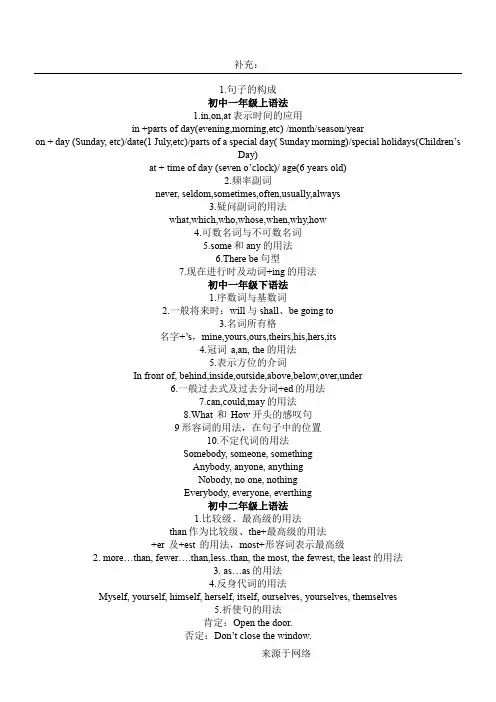
补充:1.句子的构成初中一年级上语法1.in,on,at表示时间的应用in +parts of day(evening,morning,etc) /month/season/yearon + day (Sunday, etc)/date(1 July,etc)/parts of a special day( Sunday morning)/special holidays(Children’sDay)at + time of day (seven o’clock)/ age(6 years old)2.频率副词1.比较级、最高级的用法than作为比较级、the+最高级的用法+er 及+est 的用法,most+形容词表示最高级2. more…than, fewer….than,less..than, the most, the fewest, the least的用法3. as…as的用法4.反身代词的用法Myself, yourself, himself, herself, itself, ourselves, yourselves, themselves5.祈使句的用法肯定:Open the door.否定:Don’t close the window.礼貌些:Please….6.表示建议should和had better的用法7.may来表示可能性的用法(区别初一下7,may作为询问语气的用法)8.不定式用法9.用不定式表示目的,用in order to表示目的10. A.“动词+宾语+不定式”结构,即,动词+宾语+to do(不定式)可用这类结构的常用动词有?advise, allow, ask, bear, beg, bother, cause, command, determine, encourage, expect, forbid, force, get, hate, help, intend, invite, leave, like, mean, need, order, permit, persuade, prefer, request, remind, request, teach, tell, trouble, want, warn, wish等。
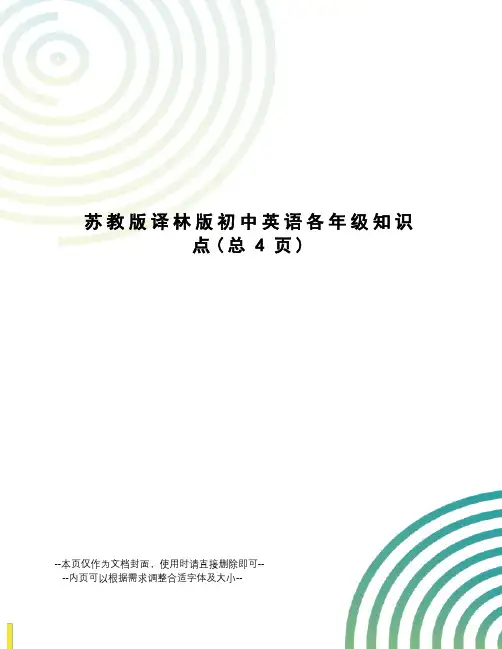
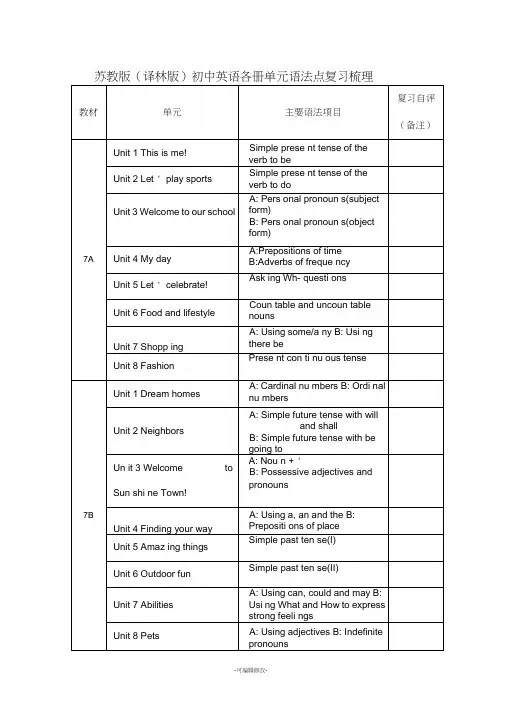

—-可编辑修改,可打印——别找了你想要的都有!精品教育资料——全册教案,,试卷,教学课件,教学设计等一站式服务——全力满足教学需求,真实规划教学环节最新全面教学资源,打造完美教学模式七年级英语下册知识点总结Unit 1 Dream homes一、重点词组、句型1、Would you like to live in the palace, Eddie? 埃迪,你想住宫殿里吗?①Would you like sth? 肯定回答:Yes, please. 否定回答:No, thanks.②Would you like to do sth? 肯定回答:Yes, I’d like/love to. 否定回答:I’d like/love to, but…2、There are twenty restaurants in town. 镇上有二十家餐馆。
There are about 8,000,000 people living in London. 大约有八百万人住在伦敦。
①表示某地有……,用there be 句型,谓语动词就近原则。
There __________(be) an art room, a music room and two computer rooms in our school.②表示有事情要做,用there be sth to do。
There are lots of things ___________(see) in Beijing..③表示有某人正在做某事,用there be sb doing sth.。
On game shows, there are always famous people___________(talk) about their lives.3、I live in a town 15 miles from London. 我住在离伦敦15英里的一个镇上。
be far (away) from 离……远,但出现具体距离时,不用farMy home is __________________from the school.My home is 5 kilometres ___________from the school. A. away B. far C. close D. next to 4. have fun with sb./sth. 和某人/某物玩得开心have fun doing sth. 做某事很开心have(has/had) fun= have(has/had) a good time= enjoy(enjoyed) onself(myself/yourself/youselves……)5、I also have a bedroom of my own. =I also have my own bedroom. 我也有自己的房间。
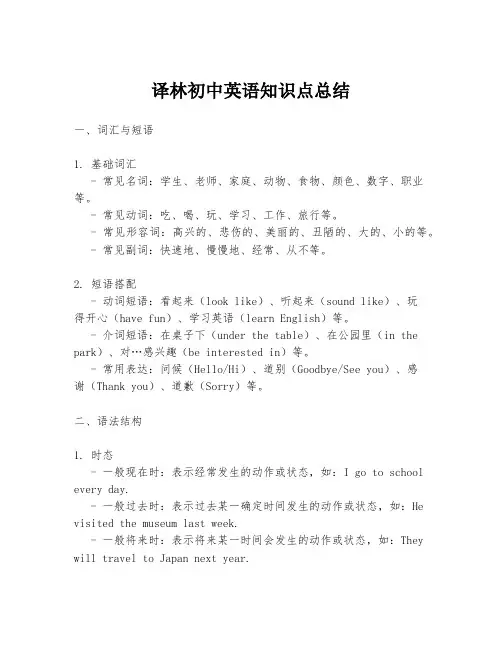
译林初中英语知识点总结一、词汇与短语1. 基础词汇- 常见名词:学生、老师、家庭、动物、食物、颜色、数字、职业等。
- 常见动词:吃、喝、玩、学习、工作、旅行等。
- 常见形容词:高兴的、悲伤的、美丽的、丑陋的、大的、小的等。
- 常见副词:快速地、慢慢地、经常、从不等。
2. 短语搭配- 动词短语:看起来(look like)、听起来(sound like)、玩得开心(have fun)、学习英语(learn English)等。
- 介词短语:在桌子下(under the table)、在公园里(in the park)、对…感兴趣(be interested in)等。
- 常用表达:问候(Hello/Hi)、道别(Goodbye/See you)、感谢(Thank you)、道歉(Sorry)等。
二、语法结构1. 时态- 一般现在时:表示经常发生的动作或状态,如:I go to school every day.- 一般过去时:表示过去某一确定时间发生的动作或状态,如:He visited the museum last week.- 一般将来时:表示将来某一时间会发生的动作或状态,如:They will travel to Japan next year.2. 句型- 肯定句:I am a student.- 否定句:I am not a student.- 疑问句:Are you a student?- 特殊疑问句:What is your name? / Where are you from?3. 语态- 被动语态:表示动作的承受者,如:The book was written by the author.4. 非谓语动词- 动名词:作为名词使用,如:Swimming is my hobby.- 分词:作为形容词或副词使用,如:The running boy is my friend.- 不定式:作为名词、形容词、副词等,如:To err is human.三、阅读理解1. 技巧- 快速阅读:通过扫读(skimming)和略读(scanning)快速获取文章大意。
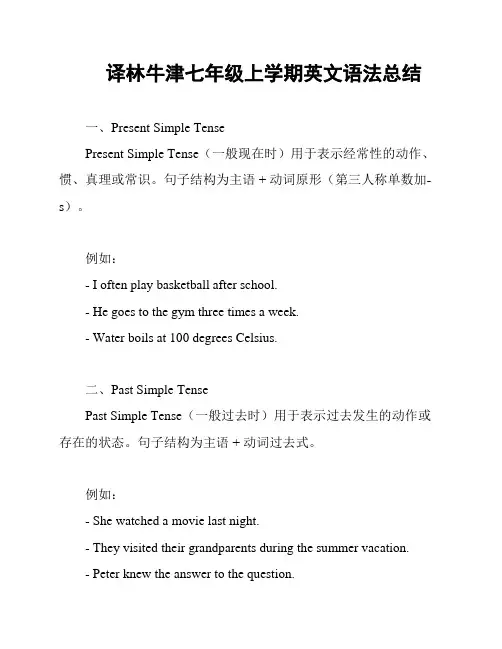
译林牛津七年级上学期英文语法总结一、Present Simple TensePresent Simple Tense(一般现在时)用于表示经常性的动作、惯、真理或常识。
句子结构为主语 + 动词原形(第三人称单数加-s)。
例如:- I often play basketball after school.- He goes to the gym three times a week.- Water boils at 100 degrees Celsius.二、Past Simple TensePast Simple Tense(一般过去时)用于表示过去发生的动作或存在的状态。
句子结构为主语 + 动词过去式。
例如:- She watched a movie last night.- They visited their grandparents during the summer vacation.- Peter knew the answer to the question.三、Present Continuous TensePresent Continuous Tense(现在进行时)用于表示现在正在进行的动作。
句子结构为主语 + am/is/are + 动词-ing。
例如:- I am studying for the English exam right now.- They are playing soccer in the park.- She is reading a book at the moment.例如:- This book is more interesting than that one.- Tom is taller than his brother.- The red car is faster than the blue one.五、SuperlativesSuperlatives(最高级)用于表示多个事物中最高程度的特征。
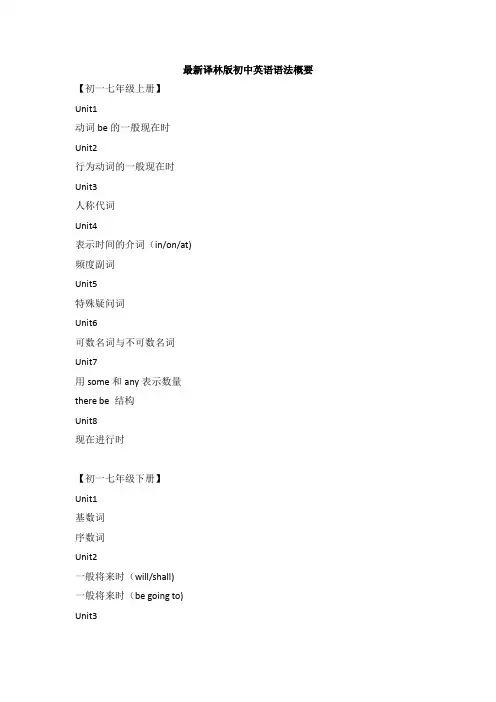
最新译林版初中英语语法概要【初一七年级上册】Unit1动词be的一般现在时Unit2行为动词的一般现在时Unit3人称代词Unit4表示时间的介词(in/on/at)频度副词Unit5特殊疑问词Unit6可数名词与不可数名词Unit7用some和any表示数量there be 结构Unit8现在进行时【初一七年级下册】Unit1基数词序数词Unit2一般将来时(will/shall)一般将来时(be going to)Unit3名词所有格形容词性物主代词和名词性物主代词Unit4冠词a/an/the方位介词Unit5一般过去时(1)Unit6一般过去时(2)Unit7情态动词can/could/mayWhat/How感叹句Unit8形容词不定代词【初二八年级上册】Unit1形容词比较级和最高级Unit2数量的比较副词比较级和最高级Unit3as...as的用法反身代词Unit4祈使句用should和had better提建议Unit5情态动词may的用法动词不定时作宾语Unit6动词不定时作目的状语动词不定时作宾语补足语Unit7动词及五种基本句型Unit8过去进行时when,while和as的用法【初二八年级下册】Unit1现在完成时(1)Unit2现在完成时(2)Unit3现在完成时(3)Unit4疑问词+动词不定式must和have to的用法Unit5enough to的用法too...to的用法Unit6It is +adj(for.../of)+to infinitive句型Unit7被动语态(1)被动语态的一般现在时和一般过去时Unit8被动语态(2)被动语态的一般将来时被动语态(2)。
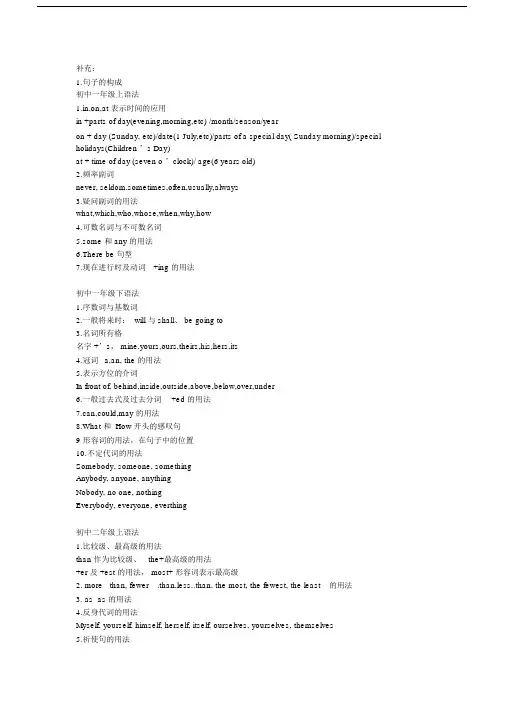
补充:1.句子的构成初中一年级上语法1.in,on,at 表示时间的应用in +parts of day(evening,morning,etc) /month/season/yearon + day (Sunday, etc)/date(1 July,etc)/parts of a special day( Sunday morning)/special holidays(Children ’s Day)at + time of day (seven o ’clock)/ age(6 years old)2.频率副词never, seldom,sometimes,often,usually,always3.疑问副词的用法what,which,who,whose,when,why,how4.可数名词与不可数名词5.some 和 any 的用法6.There be 句型7.现在进行时及动词+ing 的用法初中一年级下语法1.序数词与基数词2.一般将来时: will 与 shall、 be going to3.名词所有格名字 +’s, mine,yours,ours,theirs,his,hers,its4.冠词a,an, the 的用法5.表示方位的介词In front of, behind,inside,outside,above,below,over,under6.一般过去式及过去分词+ed 的用法7.can,could,may 的用法8.What 和 How 开头的感叹句9形容词的用法,在句子中的位置10.不定代词的用法Somebody, someone, somethingAnybody, anyone, anythingNobody, no one, nothingEverybody, everyone, everthing初中二年级上语法1.比较级、最高级的用法than 作为比较级、the+最高级的用法+er 及 +est 的用法, most+ 形容词表示最高级2. more than, fewer .than,less..than, the most, the fewest, the least的用法3. as as 的用法4.反身代词的用法Myself, yourself, himself, herself, itself, ourselves, yourselves, themselves5.祈使句的用法肯定: Open the door.否定: Don’tclose the window.礼貌些: Please .6.表示建议should 和 had better 的用法7.may 来表示可能性的用法(区别初一下7,may 作为询问语气的用法)8.不定式用法9.用不定式表示目的,用in order to 表示目的10. A.“动词 +宾语 +不定式”结构,即,动词+宾语 +to do (不定式)可用这类结构的常用动词有advise, allow, ask, bear, beg, bother, cause, command, determine, encourage, expect, forbid, force, get, hate, help, intend, invite, leave, like, mean, need, order, permit, persuade, prefer, request, remind, request, teach, tell, trouble, want, warn, wish等。
苏教版初中语法知识点总结一、名词名词是我们表达事物的基本词类,它分为可数名词和不可数名词。
1.可数名词可数名词是指我们可以数数的事物的名称,如book、table、student等。
可数名词有单数和复数之分,名词加-s或-es构成复数,如books、tables、students等。
2.不可数名词不可数名词是指我们不能直接数数的事物的名称,如water、milk、rice等。
不可数名词没有复数形式,它们既可以表示一个整体也可以表示一部分,需要结合量词来进行量的表示,如a glass of water、two cups of milk等。
二、冠词冠词是用来修饰名词的词汇,分为不定冠词和定冠词。
1.不定冠词不定冠词是指不特指某个事物或人的冠词,只表示泛指,如a、an。
a用在以辅音音素开头的词前,an用在以元音音素开头的词前。
2.定冠词定冠词是指特指某个事物或人的冠词,表示特指,如the。
定冠词the用在特指的名词前,表示这个、这些。
三、代词代词是用来代替名词的词语,分为人称代词、物主代词、指示代词、疑问代词、不定代词和相互代词等。
1. 人称代词人称代词是用来代替人或事物的代词,分为主格和宾格,主格用在做主语的情况下,宾格用在做宾语的情况下,如I、you、he、she、it、we、they。
2. 物主代词物主代词是用来表示所有关系的代词,分为形容词性物主代词和名词性物主代词,如my、your、his、her、its、our、their、mine、yours、hers、ours、theirs等。
3. 指示代词指示代词是用来指示特定事物或人的代词,分为近指示和远指示,如this、that、these、those等。
4. 疑问代词疑问代词是用来提问的代词,通常用来引导疑问句,如what、which、who、whom、whose等。
5. 不定代词不定代词是用来代替不特指、不确定的事物或人的代词,如some、any、no、every、none、few、several等。
初中三年(七年级——九年级)语法知识总结7A语法Unit1This is me!一般现在时(be)am,is,are1.一般现在时的定义表示主语具备的性格、能力、特征和状态2.结构:肯定句:主语+be+...否定句:主语+be+not+...一般疑问句及回答:be+主语+...?(肯定回答)Yes,主语be.(否定回答)No,主语be not(aren’t,isn’t).3.一般现在时中be动词的使用。
(一)be动词:动词be(am,is,are)说明身份、年龄、状态等(二)be动词的人称变化:第一人称I,后面的动词用am;第三人称he/she/it,后面的动词用is;第一人称复数we,第二人称you,第三人称复数they,后面的动词用are.(三)be动词在一般疑问句和否定句中的表达:动词be一般现在时的一般疑问句,把be提到句首,它的否定句式是在be后直接加not。
(四)be动词的具体使用:1.be+形容词2.be+名词3.be+介词短语4.be+形容词短语5.be+副词6.用于表示时间:Unit2Let’s play sports!一般现在时(do)1.定义:表示经常的或习惯性的动作;表示客观真理或事实;表示目前的爱好、能力。
2.常见时间短语:often,sometimes,usually,always,every week,on Sundays,once a month等3.结构:肯定句:主语+V.+...否定句:主语+do/does+not+V.+...一般疑问句及回答:Do/Does+主语+...?(肯定回答)Yes,主语do/does.(否定回答)No,主语do/does not(don’t,doesn’t).4.第三人称单数形式及其变化规则当主语是第三人称单数时,谓语动词要用第三人称单数形式(三单)动词变化规则:(1).规则动词+s,如makes,eats(2).s,sh,ch,ss,x结尾+es,如teaches,misses,fixes,finishes(3).辅音字母+y结尾,把y改为ies,如carries,cries(4).特殊变化,如go---goes,do---does,have---hasUnit3Welcome to our school!人称代词1.定义:代替人或物的名词2.人称代词的主宾格在句子中做的成分(1)人称代词的主格在句子中做主语,一般位于句首。
(完整版)译林剑桥七年级上学期英语语法总结一、名词(Noun)名词是指表示人、事物、动物、地方等的词语。
名词有单数和复数两种形式,并可用于表示所有关系。
1. 单数与复数形式名词的单数形式一般是在词尾直接加-s,但也有一些特殊情况,如:- 以 s、sh、ch、x 结尾的名词,加 -es,如:class-classes、box-boxes;- 以辅音字母 + y 结尾的名词,变 y 为 i,再加 -es,如:city-cities、baby-babies。
名词的复数形式一般是在词尾直接加-s,但也有一些特殊情况,如:- 以 s、sh、ch、x 结尾的名词,只加 -es,如:bus-buses、watch-watches;- 单复数形式一样的名词,如:sheep-sheep、fish-fish。
2. 所有格名词的所有关系一般在名词后面加 's,如:- 单数名词一般直接加 's,如:Tom's book;- 复数名词以 -s 结尾时,只需加 ',如:the boys' pencils;- 复数名词以 -s 结尾时,加 's,如:the children's toys。
二、动词(Verb)动词是表示动作、作为谓语的词语。
1. 动词的时态- 现在时:表示现在正在进行的动作或状态,如:I play basketball.- 过去时:表示过去发生的动作或状态,如:I played basketball.- 将来时:表示将来要发生的动作或状态,如:I will play basketball.2. 动词的形式- 一般形式:即原形,表示一般的动作或状态,如:play。
- 第三人称单数:在第三人称单数主语前加 -s,如:plays。
- 现在分词:以-ing 结尾,表示正在进行的动作,如:playing。
- 过去分词:常和助动词 have、has、had 连用,表示动作已经完成,如:played。
语法总结(初一初二)(word版可编辑修改)苏教版译林牛津重点初中英语语法总结(初一初二)(word版可编辑修改) 编辑整理:尊敬的读者朋友们:这里是精品文档编辑中心,本文档内容是由我和我的同事精心编辑整理后发布的,发布之前我们对文中内容进行仔细校对,但是难免会有疏漏的地方,但是任然希望(苏教版译林牛津重点初中英语语法总结(初一初二)(word版可编辑修改))的内容能够给您的工作和学习带来便利。
同时也真诚的希望收到您的建议和反馈,这将是我们进步的源泉,前进的动力。
本文可编辑可修改,如果觉得对您有帮助请收藏以便随时查阅,最后祝您生活愉快业绩进步,以下为苏教版译林牛津重点初中英语语法总结(初一初二)(word版可编辑修改)的全部内容。
精心整理语法总结(初一初二)(word版可编辑修改)补充:1.句子的构成初中一年级上语法1。
in,on,at表示时间的应用in +parts of day(evening,morning,etc)/month/season/year精心整理语法总结(初一初二)(word版可编辑修改)on + day (Sunday, etc)/date(1 July,etc)/parts of a special day( Sunday morning)/special holidays(Children's Day)at + time of day (seven o’clock)/ age(6 yearsold)精心整理语法总结(初一初二)(word版可编辑修改)2。
频率副词never,seldom,sometimes,often,usually,always3。
疑问副词的用法what,which,who,whose,when,why,how 4。
可数名词与不可数名词精心整理语法总结(初一初二)(word版可编辑修改)5.some和any的用法6.There be句型7。
现在进行时及动词+ing的用法初中一年级下语法1。
初一初二英语语法知识点归纳总结一、名词(Noun)名词是指人、事物、地点或抽象概念的名称。
在句子中可以作主语、宾语、表语和定语等。
1. 可数名词(Countable Nouns)可数名词有单数和复数之分,可以使用不定冠词a/an或者数词+复数形式来表示多个。
2. 不可数名词(Uncountable Nouns)不可数名词没有复数形式,表示不可分割的物质、抽象概念等,通常用量词来表示数量。
3. 特殊名词(Proper Nouns)特殊名词是特指某个人、地点或者事物的名词,通常首字母要大写。
二、代词(Pronoun)代词是替代名词起指代作用的词语,可以替代人、事物等进行代替。
1. 人称代词(Personal Pronouns)人称代词分为主格和宾格,表示说话人、听话人或者与说话人和听话人有关的人或事物。
2. 物主代词(Possessive Pronouns)物主代词表示所有关系,用来表示所属关系。
3. 反身代词(Reflexive Pronouns)反身代词侧重指代自己,常用来加强宾语的语气。
三、动词(Verb)动词是句子的谓语,表示动作、状态、事件等。
1. 动词的时态(Verb Tenses)- 一般现在时(Simple Present Tense):表示习惯性行为或客观事实。
- 现在进行时(Present Continuous Tense):表示现在正在进行的动作。
- 一般过去时(Simple Past Tense):表示过去发生的动作或状态。
- 过去进行时(Past Continuous Tense):表示过去某一时刻正在进行的动作。
- 一般将来时(Simple Future Tense):表示将来发生的动作或状态。
- 将来进行时(Future Continuous Tense):表示将来某一时刻正在进行的动作。
2. 动词的语态(Voice)- 主动语态(Active Voice):表示主语是动作的执行者。
苏教版译林牛津初中英语语法总结(初一初二)补充:1.句子的构成初中一年级上语法1.in,on,at表示时间的应用in +parts of day(evening,morning,etc) /month/season/year on + day (Sunday, etc)/date(1 July,etc)/parts of a special day( Sunday morning)/special holidays(Children’s Day) at + time of day (seven o’clock)/ age(6 years old)2.频率副词never, seldom,sometimes,often,usually,always3.疑问副词的用法what,which,who,whose,when,why,how4.可数名词与不可数名词5.some和any的用法6.There be句型7.现在进行时及动词+ing的用法初中一年级下语法1.序数词与基数词2.一般将来时:will与shall、be going to3.名词所有格名字+’s,mine,yours,ours,theirs,his,hers,its4.冠词a,an, the的用法5.表示方位的介词In front of, behind,inside,outside,above,below,over,under6.一般过去式及过去分词+ed的用法7.can,could,may的用法8.What 和How开头的感叹句9形容词的用法,在句子中的位置10.不定代词的用法Somebody, someone, somethingAnybody, anyone, anythingNobody, no one, nothingEverybody, everyone, everthing初中二年级上语法1.比较级、最高级的用法than作为比较级、the+最高级的用法+er 及+est 的用法,most+形容词表示最高级2. more…than, fewer….than,less..than, the most, the fewest, the least的用法3. as…as的用法4.反身代词的用法Myself, yourself, himself, herself, itself, ourselves, yourselves, themselves5.祈使句的用法肯定:Open the door.否定:Don’t close the window.礼貌些:Please….6.表示建议should和had better的用法7.may来表示可能性的用法(区别初一下7,may作为询问语气的用法)8.不定式用法9.用不定式表示目的,用in order to表示目的10. A.“动词+宾语+不定式”结构,即,动词+宾语+to do(不定式)可用这类结构的常用动词有advise, allow, ask, bear, beg, bother, cause, command, determine, encourage, expect, forbid, force, get, hate, help, intend, invite, leave, like, mean, need, order, permit, persuade, prefer, request, remind, request, teach, tell,trouble, want, warn, wish等。
苏教版译林牛津初中英语语法总结(初一初二)
1、句子的构成初中一年级上语法
1、in,on,at表示时间的应用in +parts of
day(evening,morning,etc)
/month/season/yearon + day (Sunday, etc)/date(1 July,etc)/parts of a special day( Sunday morning)/special holidays(Children’s Day)at + time of day (seven
o’clock)/ age(6 years old)
2、频率副词never,
seldom,sometimes,often,usually,always
3、疑问副词的用法what,which,who,whose,when,why,how
4、可数名词与不可数名词
5、some和any的用法
6、There be句型
7、现在进行时及动词+ing的用法初中一年级下语法
1、序数词与基数词
2、一般将来时:will与shall、be going to
3、名词所有格名字+’s,
mine,yours,ours,theirs,his,hers,its
4、冠词 a,an, the的用法
5、表示方位的介词In front of,
behind,inside,outside,above,below,over,under
6、一般过去式及过去分词+ed的用法
7、can,could,may的用法
8、What 和 How开头的感叹句9形容词的用法,在句子中的
位置
10、不定代词的用法Somebody, someone, somethingAnybody, anyone, anythingNobody, no one, nothingEverybody, everyone, everthing初中二年级上语法
1、比较级、最高级的用法than作为比较级、the+最高级的
用法+er 及+est 的用法,most+形容词表示最高级
2、more…than, fewer…、than,less、、than, the most, the fewest, the least的用法
3、as…as的用法
4、反身代词的用法Myself, yourself, himself, herself, itself, ourselves, yourselves, themselves
5、祈使句的用法肯定:Open the door、否定:Don’t
close the window、礼貌些:Please…、6、表示建议 should和had better的用法
7、may来表示可能性的用法(区别初一下7,may作为询问语气的用法)
8、不定式用法
9、用不定式表示目的,用 in order to表示目的
10、
A、“动词+宾语+不定式”结构,即,动词+宾语+to do(不
定式)可用这类结构的常用动词有advise, allow, ask, bear, beg, bother, cause, command, determine, encourage, expect, forbid, force, get, hate, help, intend, invite, leave, like, mean, need, order, permit, persuade, prefer, request, remind, request, teach, tell, trouble, want, warn, wish等。
B、不需要加to的动词:使役动词:make, let等感官动词:see, hear等(关于各种动词的用法,后续有专题讲解)
11、句型:主语+谓语主语+谓语+宾语主语+谓语+表语主语+
谓语+间接宾语+直接宾语主语+谓语+直接宾语+间接宾语
12、过去进行时
13、when, while, as的用法及区别初中二年级下语法
1、现在完成时 Unit
12、have /has been与have /has gone 区别 Unit
23、一般过去时,过去完成时 Unit
34、疑问词+不定式Unit4What to…Who to…When to…Where to…Which to…How to…
5、Be enough to: to be+adj、+enough+不定式 Too、、、to:To be + too +adj、+不定式 unit
56、 It is+adj、+for+不定式 Unit6 It is+adj+of+不定式7、被动语态及其在一般现在时和一般过去时中的应用 Unit 78、被动语态在一般将来时中的应用 Unit8。